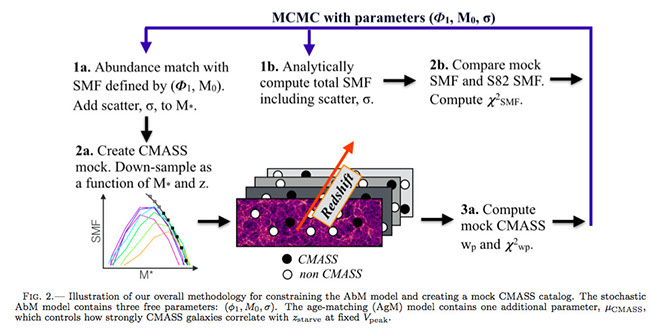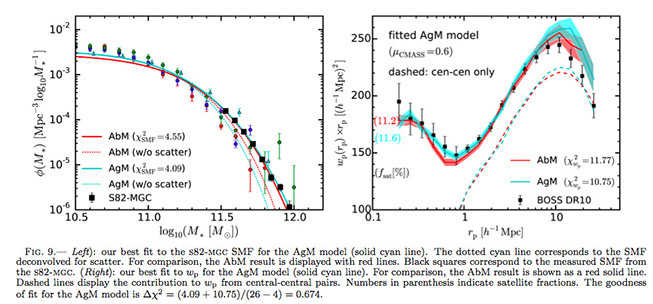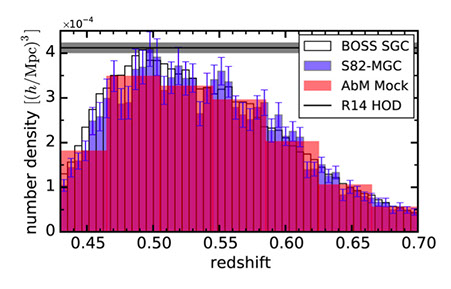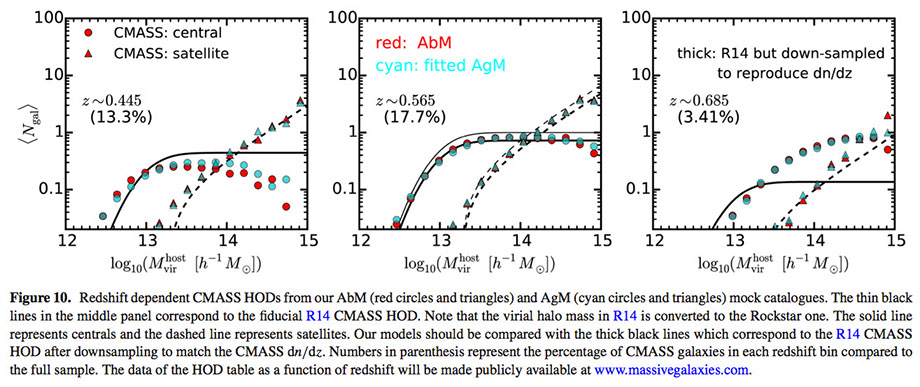MassiveGalaxies.com
Programs
Publications
Contacts
Links
HOME
S82-MGC
BOSS Completeness
BOSS Mocks
BCGs
BOSS Galaxy-Halo Modeling
Overview
Saito et al. 2016 used subhalo abundance matching (SHAM) to model the stellar mass function (SMF) and clustering of the Baryon Oscillation Spectroscopic Survey (BOSS) “CMASS” sample at z ∼ 0.5. The Saito et al. 2015 CMASS mock catalog accounts for the stellar mass incompleteness of CMASS as a function of redshift, reproduces the overall SMF measured from the S82-MGC, the projected two-point correlation function wp, and the CMASS dn/dz.
Our mocks are designed with the goal of reproducing the small scale clustering of CMASS (r<40 Mpc) and for building a detailed understanding of the galaxy-halo connection for this sample. For this reason, we adopt a smaller but higher resolution box (1 Gpc) compared to BOSS large-scale structure studies. Other lower resolution but larger sized mocks are available if you wish to study the large scale clustering of CMASS. In Saito et al, we pay close attention to the details of the SHAM implementation, a robust estimation of the total SMF, redshift dependant selection effects, and scatter between halo and stellar mass . Our mocks will be appropriate if your work is sensitive to the details of the CMASS galaxy-halo connection.
Our mock catalog is based on the publicly available MultiDark simulation, MDR1 (Prada et al. 2012; Riebeet al. 2013). The cosmological parameters in MDR1 are onsistent with a flat WMAP5 ΛCDM cosmology (Komatsu et al. 2009): Ωm0 = 0.27, ΩΛ = 0.73, Ωb0 = 0.047, n = 0.95, and σ = 0.82. MDR1 is a Lbox = 1.0h−1Gpc simulation with a particle mass of 8.7 × 109 h−1M⊙ (Npar = 20483 particles). We use an output at z = 0.534 which is close to the the peak of the BOSS CMASS dn/dz at z ∼ 0.55. Halos are identified using the ROCKSTAR algorithm.
Our SHAM is based on the total stellar mass function measured from the S82-MGC. We account for the stellar mass incompleteness of the CMASS sample by downsampling the mock catalog as a function of redshift in order to reproduce the CMASS SMFs as a function of redshift.
By confronting the redshift dependent clustering of CMASS with the predictions from our model, we argue that that galaxy colors are not a stochastic process in high-mass halos. Our results suggest that the colors of galaxies in high-mass halos are determined by other halo properties besides halo peak velocity and that assembly bias effects play an important role in determining the clustering properties of this sample.
In Saito et al in prep, we will provide realisic CMASS mock catalogs which also account for the color selection effects of the sample - stay tuned!

Overview of the methodology used to cosntruct Saito et al. 2015 CMASS mock catalog.

Our fits to the total stellar mass function (left) and two point correlation function (right.)

HOD Model

Name
Redshift
z = 0.445
Download tables of HOD results measured from our mocks at different redshifts.